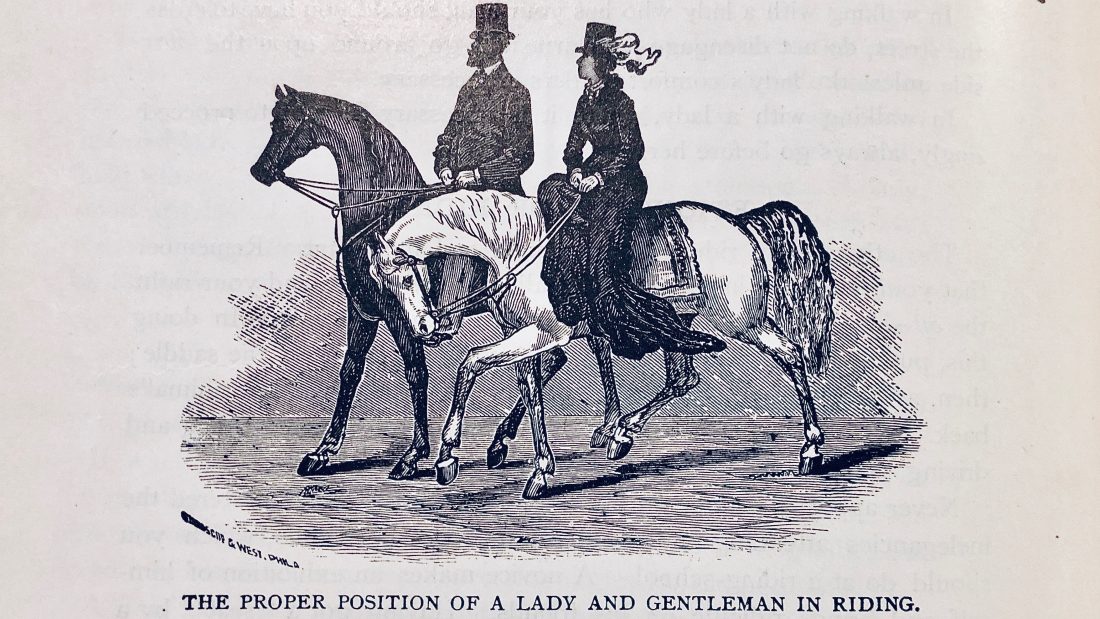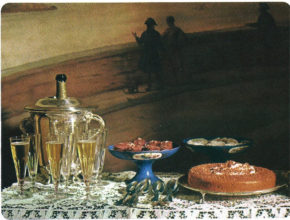When we think of etiquette that doesn’t really apply to our daily lives, horseback etiquette is at the forefront. While some of us still enjoy time with these beautiful animals, we generally do not rely on them for transportation or our livelihoods. Not so in the Regency and Victorian eras. For this first foray into horse etiquette, I’m going to look only at the act of riding singly. Carriages and traps deserve their own post.
“The etiquette of riding is very exact and important. Remember that your left when in the saddle is called near-side, and your right the off-side, and that you always mount on the near-side. In doing this, put your left foot in the stirrup; your left hand on the saddle; then, as you take a spring, throw your right leg over the animal’s back. remember, also, that the rule of the road, both in riding and driving, is, that you keep to the right.”
Social Etiquette by Maud C. Cooke, 1899
Cooke continues, “Never appear in public on horseback unless you have mastered the inelegance attending a first appearance in the saddle, which you should do at a riding-school. A novice makes an exhibition of himself, and brings ridicule on his friends.”
Riding to from the Regency to the Victorian era was an indicator of your social standing. To be a good rider, to have a good “seat”, meant that you had the money to take riding lessons, buy tack and to feed and house a horse. Now farmers may have had a number of horses, carriage drivers and delivery men as well; but the leisure to learn to ride a horse at high speed, to jump a horse, (putting an expensive animal at risk of injury) was considered the domain of the gentleman and woman. Skillful riding let everyone know how well bred you were.
As with all things well-bred, the Victorians codified the behavior surrounding horseback riding and laid down laws as to how one should behave on and around horses.
“When riding with two ladies who are both good horsewomen the gentleman should ride to the right of both, but if one or both are inexperienced, he should take his place between them. Do not touch a lay’s horse unless she requires your aid, but be ready to give prompt assistance when needed. A gentleman on horseback, meeting a lady who is walking, and who desires to speak to him, should always dismount and remain standing during the conversation. When assisting a lady to dismount, offer her your right hand, using your left for a step. The lady should slide to the ground without any effort at springing.”
Sheldon’s 20th Century Etiquette by L. W. Sheldon, 1901
Much of the Victorians’ ideas about riding come straight from their newly renewed interest in chivalry and tales of knights and fair maidens. Arthurian legends had taken a grip on Victorian society and every man worth his salt began to see himself as an heir to the round table. For many, riding on horseback was the closest they would come to a joust or crusade. On horseback was where the gentleman truly could show his dominance over nature, his strength and general superiority, but with grace and elegance. This led to many of the rules requiring men to actively act as knights to their gentlewomen.
From Social Etiquette: “In riding with ladies, recollect that it is your duty to see them in their seats before you mount. And the assistance they require must not be rendered by a groom, you must assist them yourself.”
“Taking the bridal reins in his left hand, he holds them against the saddle, while his right is tended as a movable step from which she rises to her seat. While a lady, when mounting, must sue the man’s hand as a point of departure for a strong upward impulsion of the body, rather than rest heavily upon it, the man must not withdraw his support until she is firmly int eh saddle. then, as she finds the stirrups, he hands her the reins and when sure that saddle-girth an stirrup straps are tightened or loosened to suit her convenience, he himself mounts his horse.”
The Book Of Good Manners by Frederick H. Martins, (1923)
That is something to be noted. In a society where normally the separation of yourself from work was often considered best, (think of how much of daily life a servant performed for a gentleman) here duty required your hands on attention. This was all about chivalry and is probably why we still retain a romantic view of riding today.
The Book of Good Manners also addresses greeting from horseback:
“Riding etiquette is not complex. The riding-whip raised to the front of the hat is the correct form of greeting for a man; a woman may salute with the whip, or bow. “
I like many a little girl loved horses and used to take any excuse to get on horseback. One year, I forced my poor parents to drive me every week past Malibu to a small horse farm to take lessons. I’m not sure if I though this was ever going to be a useful skill for a girl living in Santa Monica. Surfing would have been a more logical choice. Luckily, I wasn’t forced to be reasonable and even mucking a stall and cleaning shoes hold fond memories for me.
Sending love and warm horsey wishes, Cheri.


